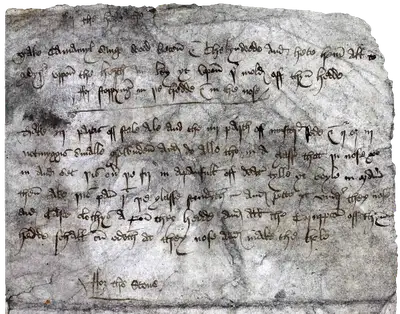Record revealed
A medieval cold and flu remedy
Stale ale, ground nutmeg and mustard seeds – would you try these medieval cures for headaches and congestion? As well as advising how to treat a runny nose, these brief recipes give surprising insights into global trade in the 15th century.
Images
Image 1 of 2

The 15th-century medical recipes.
For the hedeache
Take camamyl saug wood beten and chekynwede and hete hem all togedyr upon the herth and lay yt upon Þe mold of thyn hedde
For stoppyng in þe hedde and in the nose
Take iiii partis of stale ale and the iiii parth of mustard sede and ii or iii notmyggis smalle grwnden and do alle tho in a glasse that þi nose goo in and set þis on þe fire in a panfull of water tylle yt boyle in maner then take þis pan þat þe glasse stendyth in and sette it under they nose and caste clothys a pon they hedde and all the corupcion of thy hedde schall cum owth at they nose and make the hole
For the stons
For the headache
Take camomile, sage wood, betony and chickenweed [wild purslane] and heat them all together on the hearth and lay it upon the crown of your head
For congestion in the head and in the nose
Take four parts of stale ale and four parts of mustard seed and two or three small nutmegs ground up and do all this in a glass that your nose goes in and set this on the fire in a panfull of water until it boils to some degree. Then take this pan that the glass stands in and put it under your nose and put cloths on top of your head and all the corruption [mucus] from your head will come out of your nose and make you whole.
For the stones
[unfortunately this remedy is missing, but it could relate to kidney stones, or possibly testicles]
Image 2 of 2

The page of remedies, bound into a book of other records.
Why this record matters
- Date
- 1400–1499
- Catalogue reference
- C 47/34/12/4
These 15th-century cold and flu remedies were preserved by chance in the records of the Chancery, the formal writing house of the King. They are an example of the range of medieval records that are kept at The National Archives.
The Chancery miscellanea are a selection of records that were collected by the office of the Chancery over its long life. Often these records came in with court cases as evidence, or as part of other Chancery business, and they were kept in case they might be needed in future. Over time, the reason for this preservation has often been lost.
In this case, it is unclear why these medical recipes are still at The National Archives. Perhaps they were swept up by accident from a sickly medieval clerk’s desk into a chest of documents, and remained there until they were bound into a volume of other medieval documents in the 20th century.
The first remedy to treat a headache calls for a selection of herbs that can be grown in the English countryside. The herbs are mixed together, heated, and then put on the ‘mold’ (crown) of the head. Poultices like this one are a common part of medieval medicine.
The second remedy for ‘stoppyng’ (congestion) in the head and the nose requires the ill person to heat stale ale, mustard seeds and ground nutmeg in a small glass over boiling water, then place cloths over their head and inhale the vapours.
This recipe gives us an insight into medieval trading routes and the perhaps surprising global links of 15th-century London. All of the nutmeg in the medieval world was grown in the tiny Banda Islands in what is now Indonesia, more than 8,000 miles away from England. That nutmeg was then traded across the medieval world, often by Venetian merchants. This humble remedy, preserved on a torn piece of paper, shows us how connected the medieval world really was.
